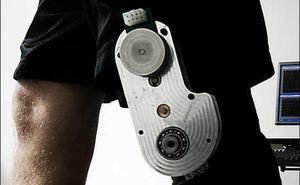EnergyKnee-strapped power harvester to do away with batteries
Battery-powered devices may soon be a thing of the past; researchers have created an innovative energy harvester to power some of the latest wearable gadgets; the energy harvester, strapped to the knee joint, converts knee motions into energy

This knee-strapped device could make batteries obsolete // Source: w-market.co.kr
Battery-powered devices could soon be a thing of the past thanks to a group of researchers who have created a novel energy harvester to power some of the latest wearable gadgets.
By strapping the energy harvester to the knee joint, a user could power body-monitoring devices such as heart rate monitors, pedometers, and accelerometers by simply walking and not have the worry of running out of power and replacing batteries. Soldiers may find this device particularly useful as they often have to carry up to ten kilograms of power equipment when on foot patrol.
The device has been described in Smart Materials and Structures journal by researchers from Cranfield University, the University of Liverpool, and University of Salford.
An Institute of Physics release reports that the energy harvesting device, which is designed to fit onto the outside of the knee, is circular and consists of an outer ring and central hub. The outer ring rotates as the knee joint goes through a walking motion. The outer ring is fitted with seventy-two plectra which “pluck” four energy-generating arms attached to the inner hub.
As an individual plectrum deflects off one of the arms — which are called bimorphs — it causes it to vibrate, much like a guitar string, and generates the electrical energy.
“A bimorph is a type of piezoelectric device capable of converting mechanical energy, such as the vibrating caused by the plectra, into electrical energy, and vice versa. Piezoelectric materials have long been used as sensors in SONAR and ultrasound scanners and have recently been the focus of attention in the field of energy harvesting,” said lead author of the study Dr. Michele Pozzi.
At the moment the device can harvest around two milliwatts of power but the researchers believe that with a few realistic improvements it could exceed thirty milliwatts of power, which could allow new generation GPS tracking, more advanced signal processing and more frequent and longer wireless transmission.
In this study, the energy harvester was tested on a knee motion simulator which reproduced the gait pattern of a human. The researchers were able to accurately control the simulator by examining the intricate detail in the movements of the knee joint by placing a selection of reflective markers on a human subject and using motion capture systems to monitor their walking pattern.
The subject was also fitted with three backpack loads to observe how the knee joint would move under a heavier load.
The knee itself is an ideal starting point for energy generation as it has a large change in angle during walking and does so at significant speeds. A device attached to the joint could therefore generate large amounts of power.
“There is an on-going project looking at manufacturing a more compact and truly wearable harvester. At the moment we are using precise but cost-effective manufacturing techniques for the plectra and casing and anticipate that remaining parts will be molded industrially, slashing the cost. I’d put a cost tag of less than £10 for each harvester on a large scale production,” continued Pozzi.
— Read more in Michele Pozzi et al., “The pizzicato knee-joint energy harvester: characterization with biomechanical data and the effect of backpack load,” Smart Materials and Structures 21, no. 7 (14 June 2012) (doi:10.1088/0964-1726/21/7/075023)
